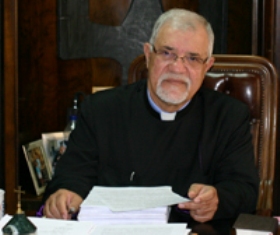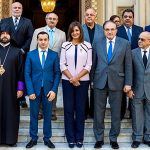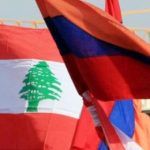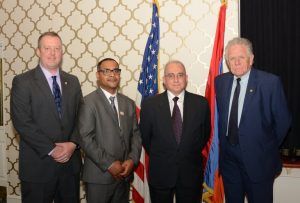Armenians in Iran

HISTORICAL BACKGROUND
Iran for Armenians has been and is a homeland, where they have been living for so many centuries, in fact the existence of the Armenians in Iran dates back to the early period of the Achamenian Dynasty (6th Century BC). Since then, Armenians actively participate in the social, cultural, military and economic life of the country. Therefore from earliest time of human history, an unbroken link has always exists between Armenia and Iran on one side and between the people of two countries on the other side. Surely the geographical neighborhood of the countries, the ethnic affinity between the two peoples, continuous cultural, social, economic and religious relationships have produced that close association that is why the Armenian people have found a warm home in Iran even after their having adopted the Christian faith as their national religion beginning from the first century.
With this background we can say that there had always been Armenians in Iran, historically speaking the first great deportation of Armenians from Armenia to Iran took place during the first period of Sassanid kingdom, namely in the 3-4 centuries. In the fifth century and onwards thousands of Armenians were brought into Iran, but one has to admit that it was only from the 11th century onwards that organized community life came into being. It was in the eleventh and twelfth centuries that segments of Armenian people were deported from Armenia to Iran during the successive and ruinous invasions of the soljuks and later of the Mongols who successively invaded Iran and Armenia in the 11th and 12th centuries.
Armenian chronicles and historical sources witness to the existence of Armenian churches and even of bishoprics, beginning from the 12th century, there is reference to two Armenian bishops from northern Iran who participated in the famous Armenian church council held in Romcla (in Asia minor, between Armenia and Cilicia) in 1179. The two bishops were the diocesan bishops of the provinces of “Her and Zarevand” and of “Salmasd and the throne of Persia”.
The major concentration of the Armenians was in the north, Tabriz being the center, there are references to Armenian communities in Khoy, Marand, Salmasd, Maragha, Sultanieh where there was even an archbishopric.
The major flow of Armenians to Iran was the deportation of large numbers of Armenians by Shah Abbas in the beginning of the 17th century. The major parts of the deportees were given a place of land on the Southern bank of the river Zayenderood, near Isfahan. Soon they built a lovely city called New-Julfa after the name of their former and prosperous city of Julfa on the river of Araxes. Others were taken to rural regions such as Charmahal and Fereidan.
At the beginning of the twentieth century due to the Genocide of 1915 thousands of Armenians fled to Iran. These immigrants who survived, first settled in Tabriz and then moved to Tehran and other cities. Later, with the fall of the first independent ArmenianRepublic in 1920 many Armenians among them political activist, intellectuals as well as dissidents of the communist regime fled to Tabriz and then to other Iranian cities. It should be noted that a substantial number of the Armenians of the different regions of Iran immigrated to the capital city of Tehran, where the largest part of Iranian Armenians community live at present, thought still there is a sizable Armenian population in New Julfa and Azerbaijan.
According to contemporary Armenian historiographers, 17th century foreign travelers and Armenian manuscripts written in New Julfa, the Armenian people soon recovered their economic strength and rebuilt their community life in religious, educational and cultural grounds and on the other side as experienced traders they greatly contributed to the improvement of foreign trade in Iran. John Carsveel, having carefully read the 17th century travelers accounts, has recognized that “0ne of the more fascinating aspects of the establishment of the Armenians in Persia was the speed with which they organized their international markets”. The French traveler Tavernier wrote in 1677 “Those people (Armenians) in a short time became so expert that there is not any sort of trade which they will not now undertake. For now they run as far as Tunquin (Tonkin), Java and Philippines and indeed all over the East except China and Japan” (quoted by Carsveel).
Armenians settled in different parts of Iran immediately focused their common efforts on building new churches in their new homeland, because they have inherited from their forth fathers a deep attachment to their church, which for centuries had been for them a spiritual and national home. There are several historical records referring to so many churches built in New Julfa in a rather short period of fifty years following their settlement in Isfahan. It should be noticed that wherever the Armenian communities established, they first built a church, then the schools, the cultural centers and other social and charitable organizations. That is why there are more than 300 churches in Iran of which forty are operational, in the cities where still we have communities. In the middle of 20th century new churches were built especially in Tehran. In Azerbaydjan diocese we have monastries where annual pilgrimage is taking place. One of the monastries is the monastry of St. Thaddeus: there are also the monastries of St. Stephanos, and Tzorzor and in the south, in New Julfa, there is the monastry of all Saviour’s, nowadays called Vank.
Today the middle East is passing through one of its most decisive and crucial periods: we are witnessing the rise of new kind of extremism and fundamentalism which can effect and in fleunce the whole region rigidly: therefore we are called to act accordingly remaining faithful to our Christian identify and faith:
ARMENIAN COMMUNITIES IN IRAN
Today there are three Armenian dioceses or bishoprics in Iran, one in Tabriz , the second in New Julfa and the third and newest is in Tehran, which is the largest due to the fact that so many Armenians have moved into Tehran . There are Armenians in Arak, Ghazvin, Rasht, Bandar Anzaly, Sary, Gorgan as well as in Urumieh and some villages around.
In recent time, we have about forty acting churches of which 16 are in Tehran diocese. The majority of Iranian Armenians are members of the ArmenianApostolicChurch. There are also few Armenian catholic and evangelical churches with their own community structure.
Armenians are largely recognized as a religious minority and as such have two members in the Iranian Parlement. Needless to say that Armenians are free in exercising and teaching their religion, moreover they are encouraged to fulfill their religious duties and obligations.
The Armenians themselves elect their own two representatives in the parlement. In matters of personal affairs such as marriage, divorce and inheritance, they are subject to the laws of their own church and this right is, to some extent, exercised by the church, albeit through the courts and judicial system of the country.
There are 26 Armenian schools in Iran, twenty of which are in Tehran, these are all public schools and belong to the Armenian community and only Armenian students are allowed in these schools, where Armenian language and religion are taught. These schools are run by the Armenian Prelacy, which through the Armenian Education Council can exercise considerable influence on these schools, especially with respect to religious education and the teaching of Armenian language and literature.
It is worthwhile to add that there are around ninty lecturers and professors in Iranian universities and some of them are heads of professional departments:
There are also several Armenian cultural, sport clubs, charitable and professional organizations which are affiliated with the Armenian Prelacy. It should be noted here that the Armenian church has always played a central and decisive role in the life of the Armenians in Iran. The Armenian church is the birth place of our soul and national identity, that is why she is not only satisfies and meets the religious and spiritual needs of the Armenian Community, but also serves in the fullest sense, as the major element in the preservation of Armenian identity.
The history of Armenian Church teaches us that Armenians throughout of their Christian history have witnessed to the Gospel and to the teaching of our Lord Jesus Christ. As Armenian Christians we witness to Jesus Christ through our attachment to Iran and its culture, civilization.
And here let me emphasize a basic fact and distinctive feature of Armenian Christian witness in Iran. For Armenian Christians Iran was not and is not a country of mission, in the modern understanding of that term. In fact Iran had known Christianity from the early times of apostolic preaching. There were also times when Christianity was not only or merely tolerated but also favoured by Sassanian kings.
CONCLUSION
Today Armenians in Islamic Republic of Iran live in harmony with their Muslim counterparts exercising and experiencing actual and living dialogue.
Today we are living in the midst of crucial events. The world has been unsecured despite the means taken by the governments and authorities concerned. This is due to the lack of trust, mutual respect, misunderstanding and ignorance of others right Violence or military actions cannot bring about real and comprehensive peace, nor achieve any success in the field of inter religious or inter communal dialogue.
Everywhere there are concerns of peace, co-existence and other dimensions of faith in which people of all religions are involved. Therefore it is not only a necessity but an imperative demand and necessity to dialogue to overcome the obstacles and differences that could hinder or interrupt a dynamic and life related dialogue which will be directed towards living together, acting together, building a new society and new world together.
Living together, acting together and building a new society this is a challenge that we are faced by. We as Armenian Christians in a minority situation, and our Muslim counterparts in a majority situation can work together as believers of one and Almighty God. The experience of the past centuries is not encouraging. The Islamic revolution in Iran brought new ideas and thoughts in this manner.
We as a minority while enjoying the freedom of worship and practice of our religious traditions, we face one major difficulty that is the decrease of our members. The number of Armenians use to be around three hundred thousands, but now they are just above 80.000 thousands. The Assyrians, Caldeans and other Christian denominations are facing the same problem. So the immigration is one of the major issues that we have to face and to deal with.
But one has to say that the migration of Christians in Iran and the whole Middle East is not a new phenomenon. This is due to a large extent, to the economic upheavals and crises. On the other hand, one has to keep in mind that we are the children of one and same country and region. We have our roots there and with other minority groups as well as with our Muslim brothers and sisters we will continue our struggle of co-existence preserving our peculiar ethnic, religious and cultural ideologies and traditions. Thousands of Armenians from Iran emigrated to India and far East including Singapore and established churches and organized their communal life. Armenians in India, Singapore and in other communities played a tremendous role in social, economical, cultural and family life. Actually the first Armenian daily news paper was published in Madras in 1792.
Secondly what is peculiar to Iran, I suppose, is the very fact that religious faith, Christian or Muslim, has been deeply incorporated into the very ethos of the society through a process of indigenization. We have nationalizes our faith in order to safeguard our ethnic identity, but at this stage we have to be careful. It is necessary that we give priority to identity with the Word of God and never with the word of man.
Thirdly the Christians being a minority in Iran can no longer afford to live in isolation from each other. They must deepen their ecumenical partnership with the churches inside the country and on the other side with the churches outside the region. In fact the Armenian Church has been involved in ecumenical relations since the 12th century. Even now the Armenian Church especially through the Catholicosate of Great House of Cilicia is pioneering the ecumenical life in local, regional and international levels. On the other side the Armenian Church has co-existed with Islam for a long time. The Armenian Church also engaged in dialogical interaction with Islam in general and with Islamic Republic of Iran in particular. We have gained valuable experience in Christian-Muslim co-existence because we have taken our highly respective diversities as richness and complementing rather than a conflicting factor in our daily life. Loyalty to our distinct identity in Christ and realistic openness to our Muslim neighbors, compatriots have to be the departing point and driving force of life and togetherness. This also is the will of God our Creator to whom we all belong.
Now dear friends as you have noticed the existence of the Armenians in Iran is not the direct result of the Armenian Genocide. But surely the Genocide influenced the life of the Armenians in Iran, because of wave of deportees from Armenia, especially from Vaspouragan region were escaped from the Genocide and established in some cities of Iran, like Arak, Tabriz, Gorgan and Tehran:
2 September 2014
Tehran-Iran
Archbishop Sebouh Sarkissian
Prelate of the Armenian Diocese of Tehran




 Արևելահայերեն
Արևելահայերեն Արևմտահայերեն
Արևմտահայերեն Русский
Русский






